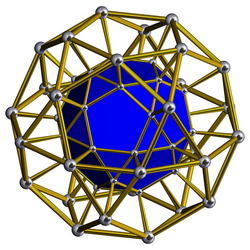Icosidodecahedral prism
| Icosidodecahedral prism | |
|---|---|
 Schlegel diagram Only one icosidodecahedron shown | |
| Type | Prismatic uniform polychoron |
| Uniform index | 58 |
| Schläfli symbol | t1,3{3,5,2} or r{3,5}×{} |
| Coxeter-Dynkin | |
| Cells | 34 total: 2 t1{5,3} 20 {}x{3} 12 {}x{5} |
| Faces | 40 {3} |
| Edges | 150 |
| Vertices | 60 |
| Vertex figure |  Rectangular pyramid |
| Symmetry group | [5,3,2], order 240 |
| Properties | convex |

In geometry, an icosidodecahedral prism is a convex uniform polychoron (four-dimensional polytope).
It is one of 18 convex uniform polyhedral prisms created by using uniform prisms to connect pairs of parallel Platonic solids or Archimedean solids.
Alternative names
- Icosidodecahedral dyadic prism (Norman W. Johnson)
- Iddip (Jonathan Bowers: for icosidodecahedral prism)
- Icosidodecahedral hyperprism
External links
- 6. Convex uniform prismatic polychora - Model 58, George Olshevsky.
- Klitzing, Richard. "4D uniform polytopes (polychora) x o3x5i - iddip".
